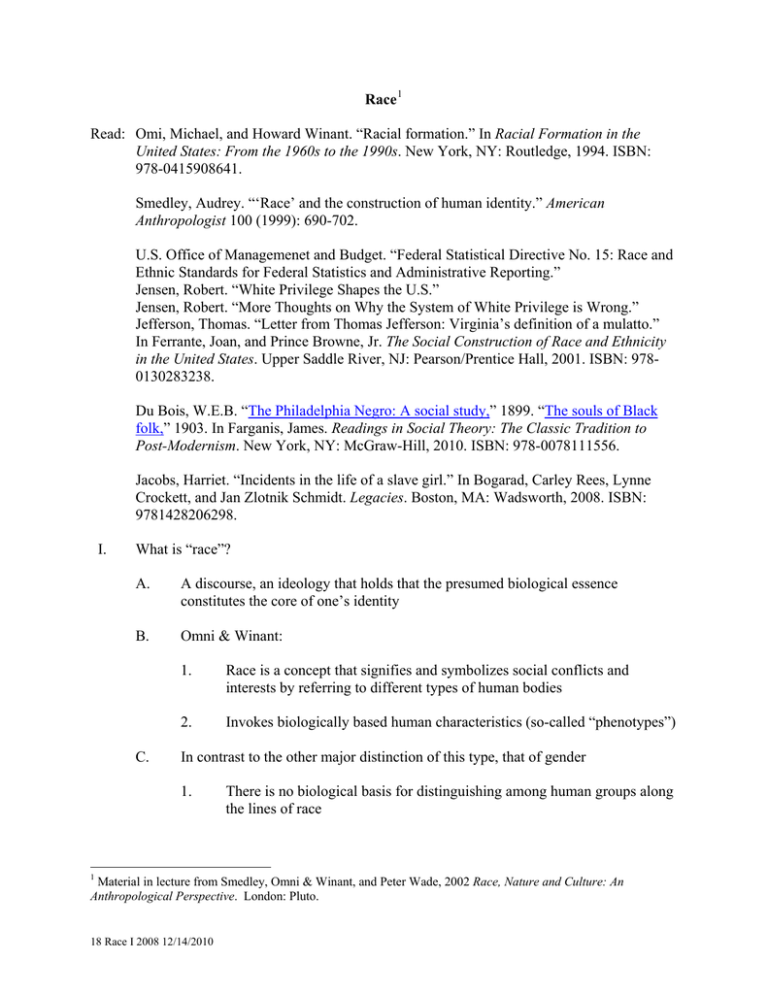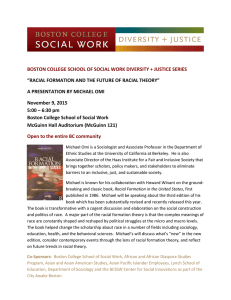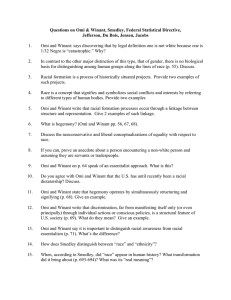
Race 1
Read: Omi, Michael, and Howard Winant. “Racial formation.” In Racial Formation in the
United States: From the 1960s to the 1990s. New York, NY: Routledge, 1994. ISBN:
978-0415908641.
Smedley, Audrey. “‘Race’ and the construction of human identity.” American
Anthropologist 100 (1999): 690-702.
U.S. Office of Managemenet and Budget. “Federal Statistical Directive No. 15: Race and
Ethnic Standards for Federal Statistics and Administrative Reporting.”
Jensen, Robert. “White Privilege Shapes the U.S.”
Jensen, Robert. “More Thoughts on Why the System of White Privilege is Wrong.”
Jefferson, Thomas. “Letter from Thomas Jefferson: Virginia’s definition of a mulatto.”
In Ferrante, Joan, and Prince Browne, Jr. The Social Construction of Race and Ethnicity
in the United States. Upper Saddle River, NJ: Pearson/Prentice Hall, 2001. ISBN: 9780130283238.
Du Bois, W.E.B. “The Philadelphia Negro: A social study,” 1899. “The souls of Black
folk,” 1903. In Farganis, James. Readings in Social Theory: The Classic Tradition to
Post-Modernism. New York, NY: McGraw-Hill, 2010. ISBN: 978-0078111556.
Jacobs, Harriet. “Incidents in the life of a slave girl.” In Bogarad, Carley Rees, Lynne
Crockett, and Jan Zlotnik Schmidt. Legacies. Boston, MA: Wadsworth, 2008. ISBN:
9781428206298.
I.
What is “race”?
A.
A discourse, an ideology that holds that the presumed biological essence
constitutes the core of one’s identity
B.
Omni & Winant:
C.
1.
Race is a concept that signifies and symbolizes social conflicts and
interests by referring to different types of human bodies
2.
Invokes biologically based human characteristics (so-called “phenotypes”)
In contrast to the other major distinction of this type, that of gender
1.
1
There is no biological basis for distinguishing among human groups along
the lines of race
Material in lecture from Smedley, Omni & Winant, and Peter Wade, 2002 Race, Nature and Culture: An
Anthropological Perspective. London: Pluto.
18 Race I 2008 12/14/2010
2
II.
Race is always and necessarily a social and historical process; a social, historical
construct
A.
B.
The notion that races exist with definable physical characteristics
1.
And, even more so, that some races are superior to others
2.
Is the result of particular historical processes…colonization by European
peoples
What kinds of social constructions?
1.
Example: in North America: category ‘black’ historically included anyone
with a known ‘drop of black blood”
2.
Omni and Winant begin their essay with court case over a woman 1/32
drop of Negro blood
3.
In contrast, in Latin America: a continuum of racial categories and often
only people who look quite African in appearance will be identified as
‘black’’
a.
“Black” has no simple referent there
1)
4.
b.
In Colombia people with very black skin can be classified as
‘blancos’ in settings where the main opposition is between
indigenous and non-indigenous
c.
Cultural and regional criteria as well as appearance are used
d.
This is changing: there is now a U.S.-style Afro-Colombian
movement, but still complex
e.
Other people are classified by a variety of terms denoting a
position in between, or various mixtures
Some dark Puerto Ricans, Cubans, others from the Islands
a.
C.
The darkest of a set of siblings might have the nickname of
“el negro,” or “la negra”
Are not classified as black at home, but find they are in the U.S.
Reasons behind variety of types of social constructions are complex
1.
But are fundamentally historical
3
2.
Connected with the type of colonial enterprise
a.
D.
Can’t assume there is such a thing as the brute fact of phenotypical variation
1.
The apparently ‘natural fact’ of phenotypical variation
a.
E.
Corresponding to the geographical encounters of Europeans in their
colonial histories
It is specific combinations of skin color, hair type and facial features that have
been worked into racial signifiers.
1.
Cannot be independent of history because only certain phenotypical
variations make racial categories
2.
And the ones that count have emerged through history
3.
DISCUSS: examples?
G.
So, can’t just recognize that races don’t exist as objective biological entities and
leave it at that
H.
Conclusion: race is not an elaborated social construction built on the basis of
phenotypical variation
1.
Because this social construction uses the particular aspects of phenotypical
variation
a.
III.
Is itself socially constructed
Physical differences that have become cues for racial distinctions are quite
particular ones
1.
F.
And sets of social relations established in each region
That were worked into vital signifiers of difference during
European colonial encounters with others
Biophysical variations cannot be foundation for a scientific construction of race
A.
We cannot come up with some objective definition about phenotypical variation
as a definition of race
1.
Because it changes over time and space, gradual, fluid
4
B.
Classification schemes may “work” in one geographical region at one point in
time
1.
But race is seen as a classification scheme that applies to the entire h.
sapiens sapiens species
2.
Biophysical variations are continuous and gradual
a.
3.
No matter what classificatory scheme you come up with (and there have
been many)
a.
C.
IV.
Population boundaries overlap, are fluid and subject to
evolutionary changes
It won’t work everywhere
Conclusion: the study of race is part of that colonial, imperial history, not outside
it
Origins
A.
19th century
1.
Only then did “race” impose social meanings on physical variations
among human groups
2.
Serving as the basis of the structuring of the total society
3.
We assume this system has always existed
4.
B.
a.
We read modern meanings into, for example, Othello
b.
We think that only now are we becoming enlightened, tolerant,
multicultural
Smedley shows we are wrong
Notions of heredity and permanence have existed for a long time
1.
Kinship is sometimes constructed to go way back
a.
Old Testament patrilineal kinship structure: genealogies important
b.
West African griots (mouthpieces for elites singing their praises)
reciting long lineages—over hundreds of years
5
1)
V.
c.
But these are lineages
d.
Not racially formed
Earlier conceptions of “race”
A.
“Race” referred to a lineage
1.
VI.
All the descendants of a given set of ancestors were members of a
common stock, a “race”
B.
A classificatory term with no clear meaning: kind, type, breed, stock
C.
“Race’s” several meanings were very rarely used to refer to enslaved populations
being transported by Europeans
D.
The meaning evolved to the nineteenth-century concept of race as type
1.
In which humans were divided into a limited number of permanent racial
types
2.
Often seen as having distinct origins (despite Book of Genesis)
Evolution of modern racial awareness
A.
B.
Earlier in Europe:
1.
“Others” were religious others: Muslims and Jews
2.
But if you convert, you’re a “new Christian,” not a Jew
16th-century argument in Spain over whether the New World’s native peoples are
human or not
1.
To determine the extent to which they could be exploited and enslaved
2.
Note: encomienda system introduced slavery in that it was coerced native
labor
a.
VII.
Documented among the East African Luo
But in other respects it was not as harsh as plantation slavery
Concept of Racial Formation
A.
Omi and Winant:
6
VIII.
1.
Racial formation is the sociohistorical process by which racial categories
are created, inhabited, transformed, and destroyed
2.
Racial formation is a process of historically situated projects
3.
O & W argue that the Conquest was the greatest racial formation project
4.
In the 18th century it was found only in the American colonies
5.
Soon the ideology was present in all overseas territories colonized by
European powers
Varieties of colonization projects
A.
English experience in Ireland
1.
England had colonized Ireland: great enmity; Irish came close to being
racialized—we can say it was a proto-racial formation
2.
At its worst during 16th and 17th centuries
3.
a.
English had an abiding contempt toward Irish
b.
No concern to understand Irish customs and institutions
Jonathan Swift’s “Modest Proposal” published in 1729
a.
4.
B.
Phrase “beyond the Pale” referred to parts of colonized Ireland beyond
colonial administration
French Canada: settlers were supposed to marry indigenous wives
1.
C.
Proposed to eat the Irish, since they were causing so much trouble;
would alleviate hunger among the poor
There were so few settlers
England in the New World
1.
Lots of interaction between English settlers and Indians
a.
Indians played French and English off of each other—formed
alliances, won concessions of territory, food and goods
b.
Marriage occurred (Pocahontas)—but this was not a policy
7
2.
“Settler societies” compete with natives for the same resources—natives
are pushed off of land, exterminated
3.
Latin American experience extremely different
a.
Highland areas: encomienda: coerced labor—did not happen to
natives in the North American colonies
b.
Latin American Indians forced to grow food, other raw materials
(work in gold, silver, tin mines)
c.
Spaniards and Portuguese were unsuccessful at enslaving lowland
natives
1)
4.
IX.
So, like North America and Caribbean, began to import
African slaves
Historical factors making Britain unlike Europe:
a.
Were an island, not invaded since the Normans in 11th century
b.
France had nothing like the Magna Carta
c.
England had deposed a king, put a non-royal in charge (Cromwell)
d.
Had split from rest of Catholic Europe not long after Reformation
began (16 years—in 1533)
e.
Early rise of merchant capitalism
f.
Development of new forms of wealth, notions about individual
freedom, property rights, and self-sufficiency
g.
We understand better why they felt themselves unique, superior,
even among Europeans
New kind of identity developed in the New World: state of permanent bondage
A.
The first Africans
1.
Were very likely indentured servants, working toward their freedom
2.
They were not property during their time as indentured servants
8
B.
A system of permanent bondage developed as ideology and practice for a number
of reasons
1.
Authorities’ fear that poor whites, Indians, blacks, mulattoes might join
forces
a.
And so developed policies aimed at fostering distance, mistrust,
etc.—divide and be more secure
1)
b.
The piece we’ll read by Howard Zinn for next week
discusses this
Poor whites became constructed as whites
1)
Came to see themselves as having something in common
with the propertied class—hadn’t before
2)
Symbolized by their light skins and common origins in
Europe
c.
Various European settler groups coalesced into a white ‘racial”
category
d.
Led to magnifying and exaggerating differences between “races”
1)
e.
White, indigenous, African
And a developing ideology that held the inferiority to be natural
and/or God-given
2.
Jefferson was far more sympathetic to Indians than to the “negro race”
3.
Of course the main reason was the developing need for plantation labor in
the South
a.
Indigo, rice; later on, cotton, sugar
C.
By mid 19th century the ideology had diffused around much of the world
D.
Differences between the two “inferior” races:
1.
Indians stood for many, many things that Africans did not, right from the
beginning
a.
In part because Native Americans were endogenous and numerous
9
b.
The colonial and Republic governments had to deal with the tribes
as “nations”
a)
X.
Omi and Winant’s concept of “racial dictatorship” in America:
A.
Between 1607 and 1865 most non-whites were firmly eliminated from the sphere
of politics
B.
Consequences:
1.
Identified “American” identity as white
a.
2.
3.
Which served to negate any taint of racialized “otherness,” in both
law and custom
The racial dictatorship organized the “color line”
a.
It turned into the fundamental division in U.S. society
Racial dictatorship consolidated the oppositional racial consciousness and
organization that were originally framed by:
a.
Runaway slave communities (marronage) and slave revolts
b.
Indigenous resistance
c.
Development of nationalisms of various sorts
1)
XI.
Entering into treaties with them
“Black” where once there had been Asante or Ovimbundu
Race exclusions in U.S. became worse after end of Civil War
A.
Even though slaves had been freed
B.
Immediately after the war:
C.
1.
Back communities and families were surprisingly strong and vibrant
2.
Men could be hired as any kind of skilled laborer: carpenter, etc.
3.
Blacks voted their own into office as senators, congressmen
Exclusionary practices developed:
10
1.
Jim Crow laws
2.
Even though industrial revolution was creating great need for labor
a.
D.
Policies and practices were developed to prevent blacks from competing with
white labor and from learning new industrial skills
1.
Can’t join unions, etc.
a.
2.
E.
F.
The country turned to immigration to solve the problem
This was everywhere, not just in the South
Racist ideology already in place
Southern economy dependent on black labor
1.
So, with aid of northern industrialists who wanted cheapest raw materials
possible
2.
Jim Crow laws returned Blacks to an impoverished and dependent position
of tenant farming and sharecropping
Eugenics movement was developing, helped justify exclusionary ideology
1.
An alliance of social policy and science that aimed to restrict the breeding
of ‘races’ seen as less ‘fit’
MIT OpenCourseWare
http://ocw.mit.edu
21A.218J / WGS.170J Identity and Difference
Spring 2010
For information about citing these materials or our Terms of Use, visit: http://ocw.mit.edu/terms.








